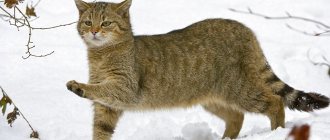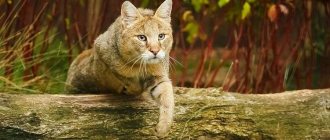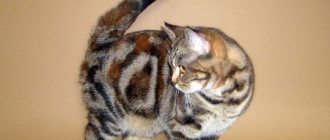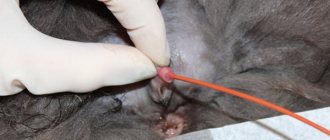Historical origin and natural habitat
The sand dunes of the Sahara are the historical habitat of this cat species. It is from the place of origin that the animals got their name. In the desert, kittens were first seen by members of the expedition led by Jean Auguste Marguerite.
Dune cat in nature
People were surprised by the endurance of the inhabitants of the sands and how well the dune cat felt in the desert. Sahara is characterized by sub-zero temperatures at night and extreme heat during the day. Animals, which later received another name - sandy ones, feel good precisely in the most arid climate: in Central Asia, on the Arabian Peninsula, in Pakistan. These points on the planet are the natural habitat of purebred representatives.
For reference! Many people mistakenly call representatives of the breed a velvet cat or cat. These animals have nothing to do with velvet.
Background
The time of the appearance of the dune cat and its further settlement are shrouded in mystery. Observations of this animal began relatively recently due to the difficult conditions in which sand cats live. What can we say, we owe the very discovery of this breed to chance.
The meeting of the general and two exotic cats marked the beginning of the study of this species
The sand cat, among all other representatives of the cat family, was lucky enough to be discovered twice. It was first discovered by the French general Jean Auguste Marguerite along with his expedition to the Sahara in 58 of the century before last.
The wild cat received its Latin name thanks to this historical meeting.
On the border between Libya and Algeria, a hiking group met two cats of unusual appearance, which could not help but attract the name. So they named this unprecedented beast in honor of the successful general - Felis margarita. The Latin designation itself was introduced by naturalist scientist Victor-Jean-François Loshomme.
There are several subspecies of the sand cat, and those that have already been discovered are far from the limit
Almost 70 years later, the dune cat again received attention, but this time from the Moscow researcher Sergei Ognev, who described it as a species. This time the sand cat was discovered in the Karakum and Kyzyl-Kum deserts. The confusion about the discoverers can be overcome if we take into account that the North African branch of the breed was discovered in the Sahara, and the Central Asian branch was discovered in the Kyzyl-Kum deserts.
What does a desert cat look like?
Bombay cat - description of Bombay cats
The sand cat is distinguished by its visual attractiveness. The thoroughbred nature of the animals is clearly visible, which is expressed in the following characteristics:
- in a large and wide head, slightly flattened in appearance;
- in very wide, low-set ears, atypical for other felines (dune cats use their ears as locators when hunting);
- in small and slanted eyes of a yellowish color, there are also representatives of the breed with emerald eyes;
- in not very thick wool - the cover is optimal for the daytime heat and night coolness of deserts. The fur is especially dense at the fingertips. This way cats don't get burned by the hot sand.
The original shape of the ears
is important! The sandy cat's fur is hypoallergenic. Even those who suffer from allergies to ordinary pets do not have a negative reaction to it.
Representatives of the breed are usually sandy in color. Thanks to this, the animal is almost invisible among the desert dunes. There are slightly dark stripes only on the back, tail and paws.
Modern naturalists distinguish several subspecies:
- Margarita;
- Thinobia;
- Scheffeli;
- Harrisoni.
The distinctive features of each of the sand cats are their variety of colors. And Thinobia also boasts a large size compared to other desert cats.
Desert cat: characteristics of the species
The dune cat can be called an extreme sportsman who is capable of surviving in the most unusual conditions. Its habitat is the desert, where some later domesticated individuals were once discovered. The cat is called sandy because it usually lives among dunes, dunes and thorny bushes. Individuals are found in the Sahara and the Arabian Desert. The places where the animal lives include Pakistan and the countries of Central Asia.
Dune cats have an unusual appearance that distinguishes them from many other individuals: a long tail, a specially shaped muzzle and short ears,
They are considered the smallest among wild cats. The body length of adult cats can reach from 60 to 80 centimeters, with almost half coming from the animal's tail. The weight of cats can range from 2.1 to 3.4 kg.
The head of desert cats is wide, slightly flattened, the ears are also wide, without tufts. The eyes are yellow, the pupils are slit-shaped.
The limbs are short and muscular. The main feature of a cat is the fur on its paw pads. Thanks to him, she can easily move along the hot sand without fear of getting burned.
The cat's coat is thick and soft, which makes it possible to maintain temperature balance. In hot weather, the animal avoids overheating, and at night - hypothermia.
Dune cats have a color similar to the color of sand, but can also be gray. There are dark stripes on the back and tail that hardly stand out. They are more noticeable on the limbs.
The chest of cats is lighter, and the tip of the tail is dark. Central Asian cats have a thicker winter coat than their summer coat, with sandy and gray shades.
There are four species of animals in total.
- The largest representatives of the species, having a dull color with a pattern that is almost not expressed. Their tail usually has 2-3 rings
- Smaller cats with brighter colors. The pattern on their coat is well defined, and the number of rings on the tail, as a rule, exceeds three.
- The smallest dune cats with the brightest colors. Their main feature is the presence of 2-6 dark rings on the tail.
- Animals with a spot on one of the ears and 5-7 rings on the tail.
It is difficult to meet a cat in its natural habitat. Firstly, because it moves silently and leaves virtually no traces, and secondly, because it comes out of hiding at night to hunt.
Dune cats attack their prey from ambush, bite into its neck and shake it with great force, breaking the cervical vertebrae. If an animal manages to catch large prey, then it can feed on it for several days and leave the shelter only when the food runs out.
Cats hunt over a large area that stretches over fifteen kilometers. In winter, they sometimes approach human habitation, but do not come into contact with domestic animals. In the desert they also need to be careful, as they easily become prey for snakes, jackals and birds of prey.
Appearance
The sand cat is one of the smallest representatives of wild cats; an adult animal weighs about 3 kg, body length does not exceed 55 cm. Its appearance is somewhat unusual and very attractive. The rather large head is slightly flattened, decorated with large ears and thick sideburns. The paws of velvet cats are short, but strong and very strong. The feet are covered with thick, coarse hair, which protects the pads from burns from hot soil.
The fur is soft and thick. At night it protects from the cold, and during the day from the heat. The color ranges from sandy to light gray with various darker stripes and markings that often blend into the overall tone. The six on the chest, chin and belly is very light.
Description of the breed
Main appearance parameters:
- medium or large build;
- weight ranges from 5 to 8 kg;
- life expectancy 13-15 years;
- the head is round and slightly elongated, the cheekbones and chin stand out well;
- the nose is small, not prominent, triangular;
- the ears are located vertically on the head, slightly to the sides;
- the eyes are oval, not very large, of different colors, the outer corners of the eyes are slightly raised;
- paws are slightly longer than standard ones, the pads are wide and oval in shape;
- the tail is quite thick at the base, narrowed towards the end, and small;
- the body is muscular, healthy, with a broad chest and arched back;
- the coat is dense, without undercoat;
- The colors of the Arabian Mau are completely different, the most popular being red and white or white spotted.
Recommended reading:
Which cat breed is considered the most affectionate?
Arabian Mau
Features of life in the wild
Russian Blue cat: description of breed and character
In the desert, the Arab cat, as the Bedouins sometimes call it, is predominantly nocturnal. The animal leaves its cozy home only at dusk. At night the animal hunts small rodents. Cats are extremely cautious, so just leaving the hole takes them quite a lot of time.
First, the hunter hides, then listens to the surrounding sounds, and only after making sure of complete safety does he continue on his way. The desert dweller also goes back into the hole with great caution. By correctly assessing their environment, cats protect themselves from predators and enemies.
Poaching and species protection
Mass hunting for these seals, which are described as similar to a lynx, has been ongoing since the discovery of the species. Fans are attracted by the unusual appearance of the animal. Dune cats are welcome representatives in zoos and private menageries. Animals are also caught for exotic lovers who keep animals at home.
Catching kittens by poachers
Important! The animal's fur is not particularly valuable, so cats are not killed for their skins.
Appendix II to the CITES Convention includes the population in the list of individuals leading a hidden lifestyle. The total number of representatives is unknown; it is believed that about 50 thousand adult individuals live in the world. Dune cats suffer from the destruction of their natural habitat, but in general they are the most prosperous subspecies of all cats.
Population status
You can easily find a variety of statements regarding the number of dune cats. Information varies from tens of thousands to a couple of hundred copies. Such a significant scatter of data occurs because no one, not even scientists, has accurate calculations. Only now, thanks to the development of video equipment, are we gradually beginning to accumulate knowledge about these secretive animals.
It is hardly possible to count all sand cats
Zoological centers relatively recently took the sand cat under their protection and began to monitor its safety. The latest generally accepted figure, expressed by scientists after several years of observing sand cats, is 50 thousand adult individuals. However, these data, obtained more than twenty years ago, are clearly outdated and need to be rechecked.
Humanity realized quite late that the sand cat needed protection
At the moment, this animal is listed in the International Red Book as “close to vulnerable”. Catching representatives of the breed without a permit issued by some reserves is strictly prohibited. Of course, a strict ban does not exclude its periodic violations.
Zoos
Those few zoos that are lucky enough to keep the sand cat take great care of it. The fact that the Israeli sand cat gave birth to offspring made the workers of the zoological center happy, who did everything so that the last remaining Arabian cats could survive in Israel. There was even a report about this joyful event, which is given below.
Video - The long-awaited baby dune cat
As already mentioned, the sand cat is a rarity for all zoos in the world. According to the latest data, only 9 individuals of this species are distributed among different zoological centers. From time to time they can be transported so that dune cats have offspring. For example, Kalahari, the partner of the Israeli cat Rotem, came from Sweden.
Adults do not get along well with each other in captivity
Due to the fact that many representatives of the breed living in zoos come from the same pair, there is a high risk of inbreeding and the birth of non-viable offspring. There is evidence that half of the cubs born in captivity die due to the mother’s refusal to care for them.
Five years ago, two dune cats were transported from the Tallinn Menagerie (Estonia) to the Nikolaev Zoo. Nothing is known about the current condition of the animals.
Poaching
As a rule, the capture of these cats is carried out by poachers, who receive quite good money for an individual sold on the black market. The price of an Arabian sand cat in some European countries reaches six thousand dollars. Dune cats are of no interest to hunters, which is why the population does not have a sharp decline in numbers. However, many scientists are concerned about the fact that the habitat of these animals is constantly decreasing due to the negative impact of humans on the environment.
Nutritional Features
Due to the scarcity of protein food in the desert, Sand cats are ready to eat absolutely any food:
- rodents (mice, gerbils, gophers, jerboas);
- spiders;
- lizards;
- small birds;
- hares;
- insects;
- snake.
At the same time, the Dune Cat, even if it is full, will never throw away the remains of its prey; it will definitely hide it in a secluded place. It will simply bury it deep in the sand, and its subtle sense of smell will help you find the supply for the next day.
Can I keep it at home?
The sand cat is a rather difficult pet to keep at home. It is hardly possible to create suitable natural conditions in an apartment. In apartments, Arabian sand representatives of the breed quickly wither away.
Chausie (cat): description of the breed F1, F2, F3, F4, F5
A private house with a yard may be suitable as a habitat. The sand cat needs a large yard to roam. Natural needs in an open area will be better fulfilled. For example, in the yard, a wild hunter will be able to hunt small rodents, benefiting his owners.
For reference! It is known that desert animals easily get along with people if they grow up in domesticated conditions from a young age. Cats are even more playful.
Character of a wild beast
The Arabian cat is a very closed creature by nature. During the day she hides almost constantly. The beast is characterized by very cautious habits and great distrust of other animals.
The Arabian cat cares about its safety. If you get closer to it, the animal closes its eyes, so that the glare does not let you know about it. When hunting, a wild cat is very swift. Representatives of the breed are capable of reaching speeds of up to 40 km/h, moving by jumping and confusing the trail.
Domestication of the dune cat
Taming a wild animal is possible at a young age. The kitten can be provided with different toys. The pet will be happy to use the offered assortment and will not refuse to play together.
Arabian raptor on a walk in the home garden
Domestic dune cats will feel more comfortable in conditions closer to natural ones. For example, it is better to equip your pets with a cozy hole for sleeping.
Important! Adaptation to the conditions of captivity for an adult cat can be lengthy. Animals may not trust people at all due to natural caution.
Habitat
The sand cat lives in conditions in which other breeds could only survive, and even then with great difficulty. Even humans rarely visit the habitats of these animals, due to the difficulty of survival in deserts. Sand cats choose the most waterless areas, remaining alone with dunes and dry bushes.
Dune cats do not like looking for easy ways
It would be a big misconception to think that sand cats are found only in the sand. Sometimes representatives of the breed can be found among the rocks adjacent to deserts, in the gorges of which they make “homes” for themselves. Rocky valleys overgrown with shrubs are also inhabited by these animals. Dune cats also come out to the banks of reservoirs.
Sand cat lifestyle
The scarcity of desert lands for food encourages sand cats to constantly move. In the conditions of sand dunes stretching for hundreds of kilometers, the path is indicated by the prey, which the cat follows.
Permanent nomads, sand cats have learned to flexibly adapt to environmental conditions
From the merciless rays of the sun, the sand cat most often takes refuge in holes, usually fox holes. These animals will not refuse the burrows of porcupines and corsacs. Sand cats also dig holes themselves, but, as a rule, small ones in order to hide from danger. Digging is easy for these animals due to their short legs. These animals leave their shelters mainly at night, since hunting in the light of the sun is hardly a feasible task.
The presence of its own powerful paws does not in the least prevent the dune cat from settling into already prepared holes
By the way! Climbing out of the hole, the sand cat freezes for several minutes. This pause allows him to "scan" the nearby area without becoming visible to enemies. The animal performs the same thorough inspection on the way home after the hunt.
No sand cat will start hunting before he is sure of his safety.
The specificity of metabolic processes in the body of a sand cat brings it closer to a camel. These animals extract the main moisture from food and are also able to go without water for a long time. Cats manage to avoid large fluid losses by being active at night.
The Arabian cat more than makes up for its small size in agility. In one night, this beast can cover an area of ten square kilometers. Covering such large areas is easy for the sand cat thanks to its “signature” movement technique. While running, this animal keeps its body very close to the ground, while its head is lowered low to create the greatest streamlining of the body.
Night runs of several kilometers are commonplace for the Arabian cat
At first glance, this method does not seem successful, however, thanks to it, the nimble beast reaches speeds of up to 40 km/h. This method of movement also allows you to remain unnoticed from the outside, since the rapid movements of the paws merge with the general background of the sand.
A rare predator is able to spot a fast sand cat even in daylight
By the way! People who had contact with Arabian cats noted the animal’s developed intelligence. When the cat encountered lanterns aimed at him, he leaned toward the ground and closed his eyes, guessing in advance that the light reflections reflected in them could give him away.
Arabian cats really do not like to get caught in the rain, which is already rare in deserts, as well as in the territories adjacent to them. These animals prefer to wait out the rains in their shelters. The burrows in which sand cats hide reach one and a half meters in depth.
Dune cats welcome their comrades from neighboring territories.
Despite the fact that the “fiefdoms” of sand cats sometimes overlap, these animals live alone, looking for a mate only during the breeding season.
Hunting
In conditions of shortage of everything, dune cats could not help but learn masterly hunting. Usually these animals do not engage in direct confrontation, since they are sometimes smaller in size than their possible prey. Arabian cats prefer to ambush their prey completely unexpectedly, confusing it.
Unpretentiousness and thriftiness are two key skills that allow the dune cat to survive in the desert
Let us separately dwell on the fights between dune cats and snakes, for which this breed is famous. Arabian cats often emerge victorious in competitions even with such dangerous individuals as the horned viper, thanks to their tactics. Cats deftly stun their opponents with a blow to the head and quickly finish with a fatal bite to the neck.
Researchers were lucky to capture the moment of intense struggle
In winter, sand cats approach settlements, but they are not interested in poultry, which is typical for Amur forest cats. We also talk about the Amur subspecies Thus, some cats can enter the territories of other cats, which is perceived by representatives of the breed completely calmly. After hunting, the stranger returns to his native places.
Diet of the dune cat
The poverty of their native lands led to the extreme unpretentiousness of sand cats in their food. To briefly summarize their diet, these animals will eat anything that moves. The most traditional representatives of the desert fauna become the sand cats' lunch:
- rodents (gerbils, jerboas);
- spiders;
- lizards;
- small birds;
- hares;
- insects;
- snakes.
Desert predators do not disdain insects
Living in conditions of constant lack of food and drink has taught sand cats to competently handle food resources. These animals never leave uneaten prey, hiding it in a secluded place until the next meal. As a rule, food supplies are buried in the sand, and a developed sense of smell easily allows a wild cat to find the cache again.
Enemies
Animals that attempt to kill the Arabian cat include birds of prey, jackals, and monitor lizards. Don’t forget about the main enemy of many wild cats – humans. But it should be noted that poachers are hardly interested in the tedious tracking of dune cats in the hot desert.
The Arabian cat is a valuable commodity in many cat markets.
Arabian cats are most readily caught for sale. Purposeful sellers who want to sell an exotic pet at a higher price to an unreasonable buyer pose a real threat to this small species at the moment.
Arab countries have not yet had time to assess the damage caused to these rare representatives of cats
The main enemy of dune cats is overgrazing and ineffective management of pasture resources in general, which is characteristic of Arab countries, which leads to the destruction of the territories native to Arabian cats.
Lifestyle
As already mentioned, this species of wild cat lives in desert, arid areas. That is why representatives of the breed are forced to hide from the scorching sun during the day. Dune cats sleep in old burrows of other small animals, such as foxes and porcupines. They live in pairs. The male and female control a territory whose area can be sixteen square kilometers. As night falls, when the temperature drops seriously, Arabian cats go hunting. Their main prey are small rodents such as lizards and jerboas. Also, cats will not miss the opportunity to hunt a tolai hare or steal bird eggs from a nest. A real delicacy for the sand cat is the horned viper. Despite the huge concentration of deadly poison, it becomes easy prey for the furry animal. Often cats come very close to human settlements, but do not show interest in domestic animals and never attack them.
Origin story
The roots of the Arabian Mau (or, as it is also called, the Arabian Mau) go deep into those centuries when cats were not yet domesticated.
To this day, this breed has retained its hunting instincts, independence, strength and patience, and a truly cat-like character. It is not known for certain how long the Arabian Mau have existed on earth. These pets were first mentioned at the beginning of the last millennium. The breed appeared independently, without human intervention.
Over time, the cat's classic features were lost due to inbreeding with other individuals, but this is what made her the Arabian we know today. The first nursery for Arabian Mau was created quite recently, in the Middle East in 2004. At the moment, the breed has temporary registration with the WCF association; disputes about the recognition of the breed are still open.
Research has been ongoing for more than four years. As a result, in 2009, the Arabian Mau received the opportunity to participate in international exhibitions. Unfortunately, the Arabian Mau has not yet received proper distribution; in the CIS countries it is very difficult to find a purebred Mau; Russians who decide to get an animal of this breed turn to the United Arab Emirates for help.
At the moment, the geography of settlement of these cats is different countries of the Persian Gulf, outside of which the population of this breed is very low. Wild desert species have been preserved to this day, in which the image of the Arabian Mau is clearly visible.
What to feed a sand cat at home
To begin with, the cat needs to adapt to the owner. You can only feed a small dune kitten by hand. The foods that are suitable for your pet are those that he ate in natural conditions, and these are:
- poultry meat (possibly with small bones);
- beef;
- fish;
- house mouse.
In addition to regular food, predators need vitamins and other useful elements. It is known that the body of this animal does not adapt well to ready-made food. Ideally, the cat will hunt on its own.
Traditional cat foods are not suitable for the Velvet cat
Important! Traditional cat food is not recommended, as it negatively affects the predator's digestive tract. The cat must periodically hunt live prey on its own.
Sphinx brush
The word “brush” originates from the English “brush”, which means brush. Kittens belonging to this variety immediately after birth have dense, uneven hair of standard length. If we compare them with velor ones, it should be noted that brushed sphinxes over time can either lose their coat or remain with it.
The Don Sphynx of the brush type usually does not participate in exhibition events (the presence of hair will not give the opportunity to receive any title), however, this variation is very often used for breeding, especially for mating with hairless kittens.
Important: Kittens of the second generation, born as a result of crossing Sphynx-Brushes with each other, will be completely naked.
Reproduction and life expectancy of the sand cat
In captivity, sand cats breed more than once annually. In nature, their reproduction is seasonal and adapted to the territory. For example, in the Sahara the breeding season continues from January to April, in Turkmenistan it begins in April, and in Pakistan it lasts from September to October.
The gestation season lasts 59-63 days, a litter usually contains 2-5 kittens, but up to 8 kittens can appear. Within two weeks, their eyes are already opening. By the age of five weeks, the kittens leave the cave and begin to take part in the hunt.
Due to premature training in hunting, numerous dune kittens die in the first months of their existence. The average lifespan of an adult sand cat that lives in the wild is 10-11 years. In captivity, this period is longer, under optimal conditions it is 13 years.
To increase life expectancy, it is important for a cat to move a lot, so apartment conditions are not very suitable for keeping a predator. A country house with sufficient open space can be an excellent alternative to the natural habitat of the Arabian cat.
A country house with a large yard would suit this cat
Important! In the reserve, animals are surrounded by qualified specialists. Veterinarians are able to provide timely assistance.
Details
Features of Mau appearance
The current standard for the Arabian Mau cat breed gives the following description of the standard:
- The head is wedge-shaped, with an elongated profile with a defined chin and moderately pronounced whisker pads. The forehead is narrow, flat in shape, the nose is of medium length.
- Large oval shaped eyes. The iris of any shade should be in harmony with the color of the coat.
- The ears are large, set wide and at an angle. There are no tassels, the inner edge is moderate.
- The body is dry, muscular, all lines are toned. Strong neck of medium length.
- Long legs, straight and well muscled. The pads of the limbs are elongated.
- The tail is wide, the length should be equal to the length of the body.
- The coat is short without undercoat. The fur is hard to the touch. Kittens are born with an elongated pile, which by the age of one year completely changes to an adult short one.
- Any color, but most often corresponds to the Van variant - white body and red limbs and spots.
INTERESTING: the rarest and most valuable Arabian Mau have an anthracite coat color.
As for size, the breed falls into the medium category. Cats are always smaller than males, weighing up to 6 kilograms. A cat can grow up to 8 kilograms.
IMPORTANT: individuals with soft fur and an excessively graceful body can be excluded from breeding.
Individual characteristics of character and habits
The most important characteristic of the breed is that they are hunter cats. The wild roots are so close that not one of the titled exhibition representatives of the breed has yet lost their talent for tactical extermination of mice on their territory. It is ideal to keep the breed in the house and give it the opportunity to walk in the territory at any time of the day.
The second advantage of the proximity of aboriginal roots is a flexible mind. If you start training a kitten on time, you can achieve very good results by the age of one year. Even the basic commands of a dog training course are within the capabilities of the breed.
The Arabian cat breed becomes attached to the family very quickly. The cat usually doesn’t have favorites; she gets along and is affectionate with everyone, including children. Can live with dogs.
IMPORTANT: the breed does not like tactile contact. Mau will play ball, feathers on a stick, but you won’t force her to lie on your lap.
Many owners note the quietness of the breed. Again, the habit of not making sounds is directly related to the long residence of the breed’s ancestors on city streets, where attracting attention with one’s voice is useless, and more often than not, simply dangerous.
The breed treats guests with interest. In general, for the Arabian Mau, a change of environment is not a problem. You can easily take your pet with you on trips.
House maintenance - how to organize daily life for the breed
The Arabian Mau breed is self-sufficient and largely independent. It does not require any special conditions; it is enough to maintain minimal external hygiene and create a balanced diet.
There are only a few aspects of nutrition that need to be considered to keep the breed healthy. Firstly, the breed is omnivorous, but this does not mean that you can give everything that is left from your table. A regular cat diet of dry, wet or natural food is suitable for the breed.
The second point in matters of nutrition is to avoid overeating. Watch portion sizes and monitor your pet's weight. Due to the fact that for centuries the Mau have been getting food for themselves, spending a lot of energy on it, at home, with plenty of feeding, they easily become obese.
Hygiene with the breed is not difficult. Coarse wool is brushed with a special brush once a week. After combing, you can walk with a damp towel to collect dust and dirt. This procedure will also help to bathe the Mau as rarely as possible, because the desert cat’s skin has an extremely negative attitude towards water.
Rubbing the eyes, ears and brushing teeth can be done as they become dirty, but it is better to accustom the cat to these procedures every other day.
IMPORTANT: the breed requires walking. If you do not live in a private house, then walks on a harness every evening are necessary.
For urban Mau living in apartments, a system of hanging shelves and houses must be equipped. While you are not at home, the cat should not be bored, otherwise it will play jumping and hide-and-seek on the kitchen set and in the cabinets.
The breed requires veterinary support once a year, unless specific cases of disease arise. Mau immunity is strong, timely vaccination and routine examinations can protect them from most diseases.
Purchasing kittens
The nearest breed kennel is located in Dubai. It is there that you can easily buy Arabian Mau kittens for only 60,000 rubles apiece.
The most famous and authoritative kennel belongs to the founder of the exhibition version of the breed, Petra Müller. The price for a kitten from it will be significantly higher.
Unfortunately, the breed is historically valuable, but has little competitiveness among many other cat breeds. Natural agility and fighting character are not supported by any expressive features of appearance, so the conquest of the world is very slow.
Where to buy a kitten
When buying a sand cat, the buyer may not count on the loyalty of veterinarians and other livestock specialists. There are no official nurseries for the species, and there is no official permission to breed kittens. The consumer will have to deal with illegal suppliers or individual traders.
For home breeding, it is best to pay attention to sand kittens. At a young age it is easier to form habits, the pet will be better adapted to home conditions.
Important! The price for a dune cat starts from 6 thousand dollars and depends on the seller. On average, they can demand 400 thousand rubles for an exotic animal.
Dune cats are distinguished by their developed hunting skills. Individuals are characterized by the ability to competently distribute food and water supplies and are unpretentious in nutrition. Purebred cats actively inhabit arid areas, which are characterized by a meager supply of food and water sources. Apart from the sand cat, practically no one else lives in the deserts, so the only danger to the wild predator is humans.
Character
Freedom-loving, wild, but at the same time very loyal, calm and taciturn.
Does not like strangers, communicates only with “his” people. Excellent hunters. They don’t like to sit on their hands for a long time, but are happy to settle somewhere closer. She is very attached to her territory and is ready to defend her right to it. The breed was formed in hot, arid countries, which made the cat very hardy.
Arabian Mau love to go for walks. You can let your pet outside without fear; nature has endowed her with an excellent topographical sense and the ability to fend for herself. This, in fact, true hunter will not miss an opportunity to catch a rodent or bird. Therefore, you need to think carefully before bringing such a cat into a house where there are hamsters or parrots. But an Arabian woman will be very happy to make friends with a cat or dog.
This breed is great with children. They dote on their pet, and the children themselves are ready to play for hours with an active and restless cat.











